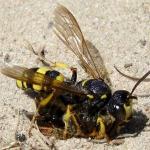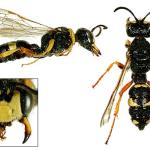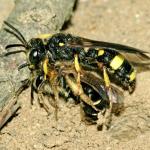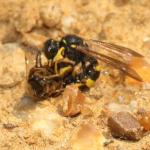Cerceris arenaria and C. rybyensis are the most common and most widely distributed species in their genus in Britain.
Often locally common in southern England, though, surprisingly, there appear to be no confirmed records from Wales. C. rybyensis also occurs in the Channel Islands and there is an unconfirmed record from south-west Scotland (Ayr (Richards, 1980)). In the collection of the Natural History Museum, London, there is a male of this species labelled 'Barons Court, Ireland' and collected on 18 July 1968 by F Wilson. This record is presumed to refer to Baronscourt in County Tyrone, and not to Baroncourt in County Tipperary.
This species is not regarded as being threatened.
Commonly associated with sandy soils, both on the coast and inland, and often nesting together with C. arenaria. It may also be associated with chalk grassland and heavier soils. An unusual record is from a suburban garden in Greater London.
Apparently single-brooded; late June to early September.
The prey consists of small and medium-sized bees of various genera, which are paralysed by stinging. The neck is also squeezed between the wasp's mandibles (malaxation); the prey dies in about two days (Lomholdt, 1975). According to Hamm and Richards (1930), this wasp hunts only bees returning to their nests with pollen, but clearly there are exceptions, as some of the above species included females free of pollen and a few males. The number of prey items per cell varies from five to eight, depending on prey size (Lomholdt, 1975).
Females of this wasp frequently nest in quite dense aggregations, usually on level, exposed compacted soil. For example, sites have included an unsurfaced road and an abandoned sand quarry in Dorset, and soil between the paving stones of a patio in Greater London. The nest consists of a deep (10-15 cm) burrow, from which short lateral burrows branch off and terminate in single cells. The upper section of the main burrow is more or less vertical, but the lower part may run horizontally (Lomholdt, 1975). Nests of this species are described and illustrated by Grozdanic and Vasic (1968) and Olberg (1959). The mature larvae spin tough, silken cocoons in which they overwinter.
Hogweed (Heracleum sphondylium), wild carrot (Daucus carota), Jersey thrift (Armeria arenaria), marigold (Calendula sp.), yarrow (Achillea millefolium) and creeping thistle (Cirsium arvense).
Amobia signata (Diptera: Sarcophagidae) has been observed following a female C. rybyensis (C R Vardy, pers. comm.). This fly is known as a cleptoparasite of many Crabronidae (including Cerceris), Apidae and Vespidae; it is apparently confined to southern Britain.
1997
Proofed: March 2012





